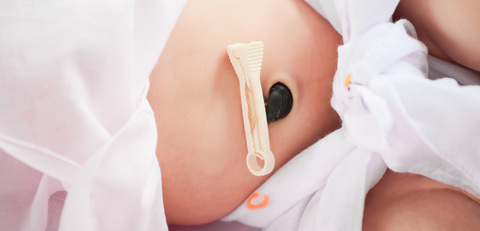The umbilical cord is a sturdy yet flexible tube that transports nutrients, blood, and oxygen from mother to baby during pregnancy. Once the baby is born, the doctor severs the connection and clamps the umbilical cord to stop bleeding. The cut, which is normally close to your baby’s navel, leaves a stub which should fall off within a week or two after birth. If germs invade the cord at the time of clamping, they are likely to cause an infection known as omphalitis. It is important for mothers to know how to identify an infected umbilical cord so as to seek medical attention in time. Keep reading to know how to take care of the umbilical cord and identify an infected one.

What happens with the Umbilical cord stump?
During the cutting and clamping process, your doctor will leave a small stump on your baby’s belly. Normally, it measures between half an inch and an inch long. The best way to keep it clean would be to protect it from diet in the first place. That means, making sure that it is lightly covered in clothing at all times. Remember to avoid tight fitting clothes as they are likely to disturb the stump's healing process. When feeding baby, use a bib to protect the cord from milk spills or baby's throw ups. It is also vital to keep the cord dry at all times: avoid washing it with water. A sponge bath is always advisable. Effective care of the umbilical cord promotes a healthy and natural fall off. Normally, it falls off within 10 to 14 days post birth, but it can take up to 21 days.

What is the best way to care for baby’s umbilical cord stump?
Listed below are some of the important things to remember and practice in your child care routine until the umbilical cord comes off.
- Always be gentle and keep your hands off the cord. Any aggression or rubbing motions to the stump can easily affect the healing process. Avoid pulling on it or even touching it. If you have to dry it for any reason, it is best to pat it with clean baby washcloth instead.
- Always keep it clean and dry. It is advisable to sponge bathe your baby until the cord comes off. Avoid the sink and the tub.
- Resist any urge to clean the cord until it falls of naturally. Traditionally, doctors advised cleaning the base of the cord with alcohol and a sponge to ensure it remains dry, but that directive changed. It is now advisable to avoid disturbing the cord until it falls off.
- When changing your baby’s diaper, fold it down to protect the cord from getting wet from the little one’s pee. There are diaper brands that have cut out an area for the cord. They are quite convenient especially for first time moms.
In case your baby experiences a messy bowel movement and some of the poop gets to the cord, it is advisable to clean it gently with soap and water. Carefully tap it dry afterward.
Although it is advisable to leave your baby’s umbilical cord alone, it is important to keep checking it for infections. It is part of the effect care routine.

How can you identify an infected Umbilical cord?
Usually, the clamped umbilical cord develops a scab at the end. Sometimes it can even bleed slightly at the base of the stump, especially when it’s ready to fall off. However, it should be light bleeding that’s easy to stop with mild pressure.
While light bleeding is normal, there are some concerning issues to look out for in case of an infection. These include:
- A red, swollen, warm, or tender skin at the base of the cord
- Pus coming out of the skin surrounding the cord
- A bad smell from the umbilical cord
- A significant amount of blood oozing from the cord
- Fever
- A fussy, uncomfortable baby, who’s also very sleepy

When should you seek help?
The umbilical cord is directly connected to the bloodstream. As such, a mild infection can turn dangerous very quickly. If an infection gains access to the bloodstream and spreads, it can easily cause sepsis, which can cause life-threatening damage to baby’s organs and tissues.
Contact your baby’s pediatrician immediately you notice any of the above mentioned symptoms of an infected umbilical cord. Umbilical cord infections have a 15 percent fatality rate in infected babies. As such, it is considered a medical emergency.
Premature babies are at a higher risk of life-threatening complications from this type of infection due to their fragile immune system. Always practice active parental care to maintain awareness of your baby’s health and development progress.
Babies are quite fragile. As parents, it is our duty to take care of them. Informed parenting is always handy when it comes to pinpointing any issues relating to your baby’s health. While it can be scary to handle the umbilical cord especially as a first time mom, remember that within a couple of weeks it is bound to fall off and reveal your baby’s tiny and cute belly button. Take care of it carefully, and when it falls off, it will serve as a reminder of one of the many milestones your baby will overcome as they grow.
As always, we'd like to emphasise that the contents of the article is not a substitute for medical consultation.

Source Links:

